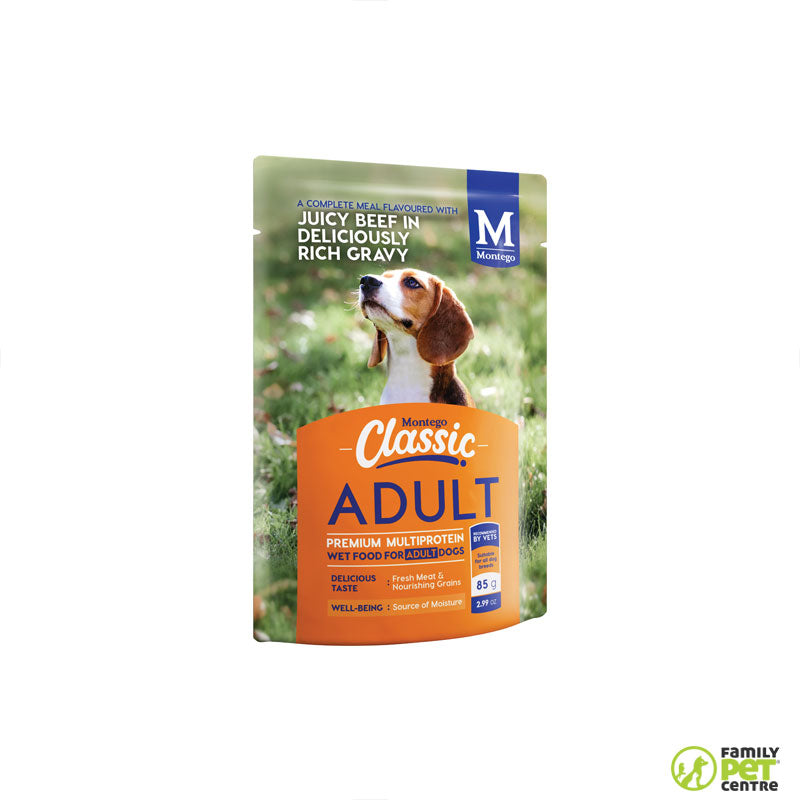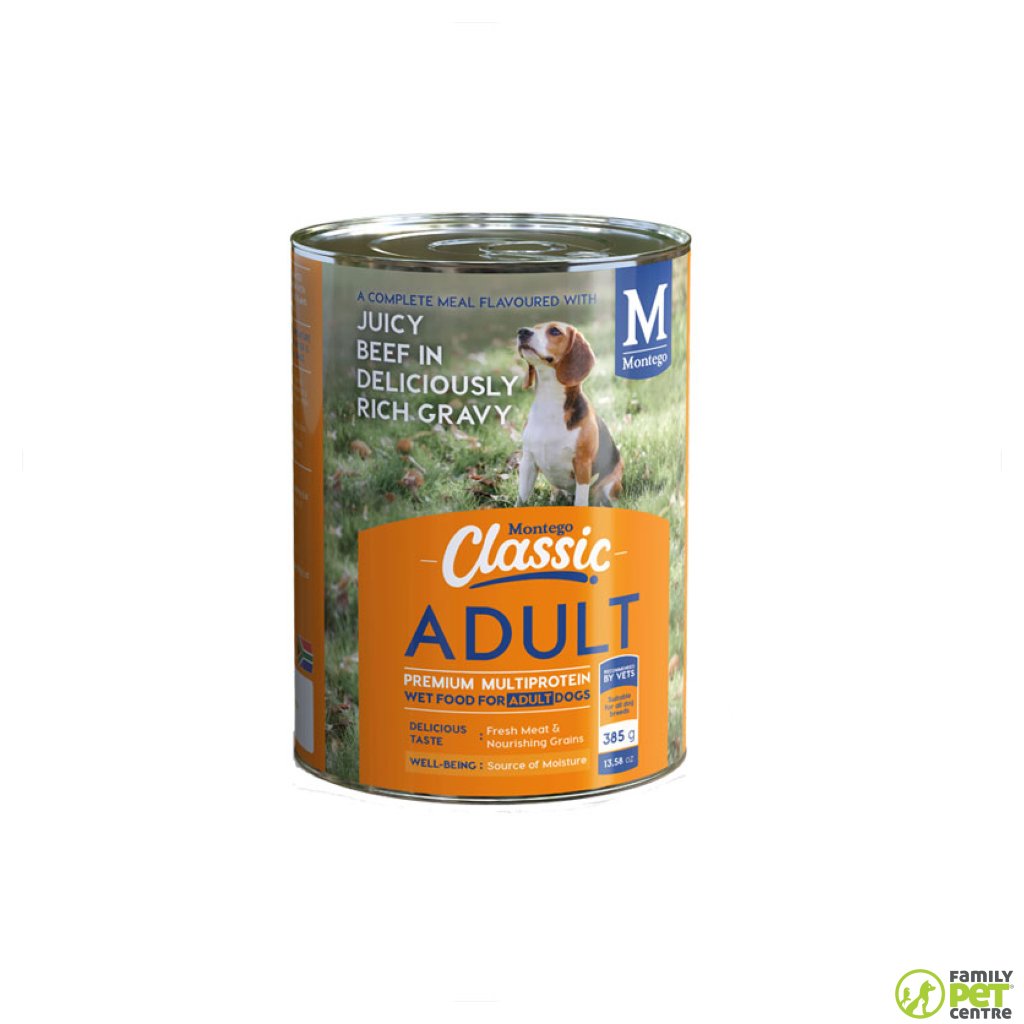| Crude protein | 6% | 33% |
| Moisture | 82% | - |
| Total fat | 3% | 22% |
| Crude fibre | 0.8% | 4% |
| Crude ash | 2% | 11% |
| Metabolisable energy | 70 kcal/100g |
- Online Enquiries: info@familypetcentre.co.za
- Centurion: +27 (0)12 941 4825
- Fourways: +27 (0)11 033 4646
Dogs
- Buy Dog Food
- Dog Treats
- Dog Beds
- Dog Doors
- Dog Kennels
- Dog Travel Gear
- Dog Walk and Toys
- Dog Clothing
- Dog Grooming
- Dog Health
- Dog Care
- Dog Accessories
- Dog Bowls and Feeders
Cats
- Buy Cat Food
- Cat Treats
- Cat Beds
- Cat Walk and Toys
- Cat Grooming
- Cat Health
- Cat Care
- Cat Carriers
- Cat Accessories
- Cat Bowls and Feeders
- Cat Litter
About Us
Reptiles & Spiders
Montego Classic Canned Adult Dog Food - Juicy Beef in Deliciously Rich Gravy
BUY NOW, PAY LATER
Ingredients:
Water sufficient for processing, chicken (including deboned), pork, beef liver, chicken fat, seasonal vegetables, wheat flour, meat by-products, sodium phosphate, guar gum and salt.
Analysis:
Benefits of wet dog food:
Wet food is generally much more appetising for dogs compared to dry food, as it closely resembles the fresh meat that dogs crave. A wet food option is great for picky eaters as an addition or alternative to dry food.
- Adds hydration to your dog's meal, wet dog food has a higher moisture content compared to dry food. Some dogs do not drink adequate amounts of water and by giving your dog wet food, you are ensuring your pet has the additional water for hydration throughout the day.
- Superior quality wet foods will use highly digestible meat as their primary ingredient, making sure your pet is receiving all the necessary nutrients needed in a balanced diet.
- Wet food has a higher moisture content than dry food, leaving your canine satiated while promoting dietary satisfaction. It is important for weight management for those dogs that can be greedy and show begging behaviours.
- A wet food diet can be an excellent choice for your dog if you’re noticing that they are turning up their nose to dry food. Montego Dog Food comes in a variety of flavours that may be to your dog's liking, making it easier to find a meal that makes your best buddy light up.
- Wet food is a better option for managing the weight of dogs than eating dry food alone. A wet diet offers a larger portion size with fewer calories, which is beneficial if you are trying to help manage your dog's weight.
Feeding Guide:
You need to adjust the amounts of pet food you are feeding to your dog to maintain an optimal weight, if you are unsure you need to speak to a veterinarian. Your pet's nutritional needs are constantly changing, especially during their first year, you should ask your vet at every checkup for any new or changed nutritional needs your dog may have.
Don't forget to offer fresh, clean water to your pet throughout the day to minimise the risk of dehydration. Dog’s water requirements are as important to their health and happiness as they are to people. Your dog's bodily functions require water to remain healthy and operative.
The main causes of dehydration:
There are many reasons why your dog may become dehydrated, including heatstroke or persistent vomiting or diarrhoea. They may not drink enough water either because of illness, fever, or just their preference.
Signs of dehydration in dogs:
It is essential that there is fresh and clean water available for your pup at all times to prevent dehydration throughout the day. It is normal for a dog's body to lose and gain water throughout the day. Panting, urinating, breathing, defecating and evaporation through their paws contribute to the loss of water, where your dog compensates by eating and drinking throughout the day.
Common signs of dehydration in dogs include:
- Loss of appetite
- Panting
- Sunken, dry-looking eyes
- Vomiting
- Dry, sticky gums with thick saliva (also known as xerostomia which is the loss of moisture in your dog's gums.)
- Reduced energy levels and lethargy
You should contact your vet if your dog is suffering from severe or continuous vomiting and or diarrhoea so they can analyse if there is a more serious underlying issue. IV fluids may be necessary if the symptoms persist to prevent extreme dehydration.
To prevent dehydration in dogs:
The best way to prevent dehydration in your dog is to provide him with a constant supply of clean, fresh water at all times of the day, including when he is inside and outside. Some dogs drink more water than others, so you will need to keep on refilling his water bowl if it starts to become noticeably empty.
Depending on the weather, the temperature, the activity levels and exercise of your best buddy, he will probably need more water on some days compared to others. On these days, you will have to ensure that there is more than enough water available for your pup to replace the water they have lost.
How to store your wet dog food:
The best way to store an open can of wet dog food is to use an airtight container and place the container into a fridge. A lid that fits the container is essential to prevent any loss of moisture and transfer of odours. On the packaging of the product, you will be able to see how long the wet dog food can be refrigerated without spoiling.
Frequently asked questions:
- At what age is a dog considered an adult?
Smaller dog breeds may be considered adults at 9 months. Larger breeds are not considered adults until 18 months of age. Some giant dog breeds will continue to have bone development until almost 2 years of age.
- When should a dog start eating adult dog food?
Your pup needs different types of food during his puppy stage that provide higher protein levels and calorie ones, as well as calories. Once he is nearing the age of six to 12 months old, it's time for him to transition into adult food.
- What is the difference between wet and dry dog food?
The main difference between wet and dry dog food is primarily the different water content. Dry dog food and wet dog food provide a nutritionally balanced diet, but they are processed in different ways. It is difficult for dogs to digest carbohydrates and there are fewer carbohydrates in wet dog food compared to dry food. This may be a reason why owners prefer to offer their dogs a wet rather than dry food option.
- Benefits of mixing wet and dry dog food.
Mixing your dog's wet and dry dog food together is an excellent choice as long both options are high-quality and meet your canine's nutritional requirements. Quality wet and dry foods are formulated to provide all of the protein, fat, vitamins, minerals and any other vital nutrients your best buddy needs to thrive.
- Do dogs need less food as they get older?
Senior dogs tend to eat a smaller amount compared to their younger companions. However, they should still have a healthy appetite and enjoy the food they are eating. If you notice a drastic change in your dog's eating habits, or that your dog refuses to eat, this may be a sign of an underlying medical problem where you should seek veterinary advice.






